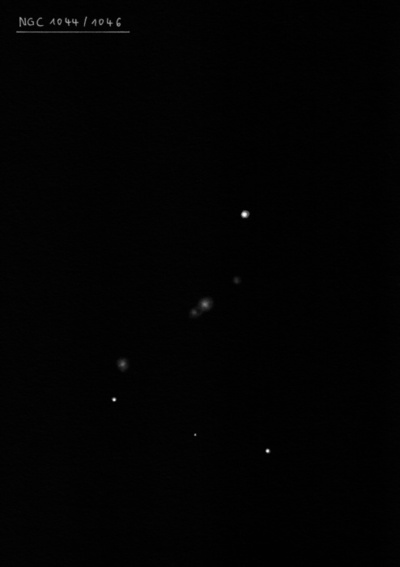
William Herschel discovered NGC 1044 = III-228 = h251, along with NGC 1046, on 7 Nov 1784 (sweep 308) and noted "eF, vS, 240 power confirmed it. Another still smaller and fainter about 1' following NGC 1046]." John Herschel measured a fairly accurate position on 8 Jan 1828 (sweep 118) and wrote "vF the p[receding] of two; a * 10m, p[receding] in same line.".
400/500mm - 17.5" (10/29/94): fairly faint, fairly small, elongated 3:2 WNW-ESE, broad concentration to a large brighter core. A mag 11 star lies 2.3' NW. Brightest of a collinear compact trio with NGC 1046 2.0' SE and MCG +01-07-022 = CGCG 414-036 off the NW edge 57" from the center (logged as "very faint, extremely small, round"). NGC 1044 appears larger than the listed dimensions probably due to the combined glow with an unresolved contact companion (PGC 3080165) at the SE edge. The four galaxies are very nearly on a straight line.
600/800mm - 24" (1/31/14): NGC 1044 is a double system with fainter LEDA 3080165 barely off the SE side. At 375x it appeared fairly faint, fairly small, slightly elongated, 24"x20", gradually increases to a sub-stellar nucleus. PGC 3080165 is attached at the SE side [19" between centers]. The companion was faint, extremely small, round, 8" diameter. This pair is flanked by CGCG 414-36 1.0' NE (noted as "faint, very small, round, 10" diameter") and NGC 1046 2.0' SE, with the collinear quartet spanning 3.0'. The four galaxies have identical redshifts, though there is no sign of interaction on the DSS.
Notes by Steve Gottlieb